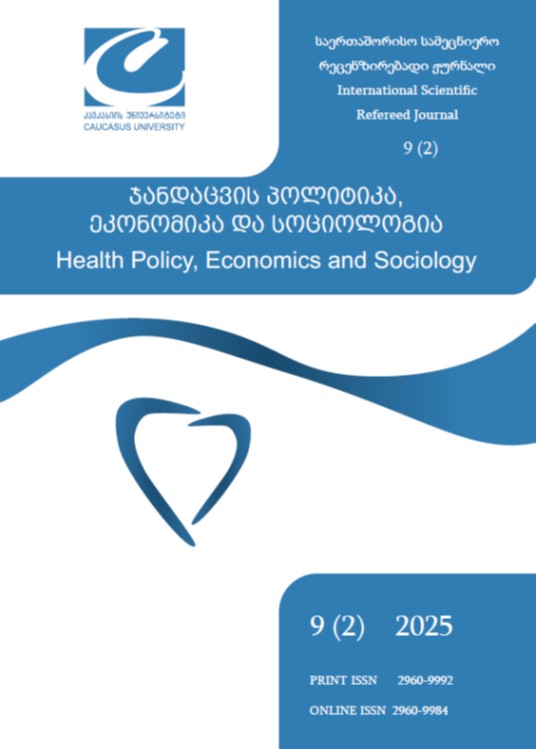ორმაგი თუ სამმაგი ცნობიერება? აფრიკელი იმიგრანტების გამოცდილება ამერიკის შეერთებულ შტატებში
DOI:
https://doi.org/10.52340/healthecosoc.2025.09.02.14საკვანძო სიტყვები:
ასიმილაცია, რასიზებული სამართლებრივი სტატუსი, ინტერსექციულობა, ორმაგი ცნობიერება, აკულტურაცია, კულტურული იდენტობა, სტრუქტურული რასიზმი, რასა და მოქალაქეობა, აფრიკელი იმიგრანტებიანოტაცია
ნაშრომი იყენებს დიუ ბოისის ორმაგი ცნობიერების კონცეფციას, რათა გააანალიზოს აფრიკელი ემიგრანტების ცხოვრებისეული გამოცდილება ამერიკის შეერთებულ შტატებში. კვლევა ეხება, თუ რას ნიშნავს იყო შავკანიანი უპირატესად თეთრკანიან საზოგადოებაში და რას ნიშნავს ცხოვრების ნავიგაცია, როგორც იმიგრანტისა, ქვეყანაში, სადაც პრივილეგიები ძირითადად განპირობებულია მოქალაქეობითა და სამართლებრივი სტატუსით. შავკანიანი იმიგრანტების გამოცდილება მნიშვნელოვნად განსხვავდება თეთრკანიანი (ევროპელი) იმიგრანტების გამოცდილებისგან რასის, ეროვნებისა და მოქალაქეობის გადაკვეთის გამო. ასევე, ადეკვატურად ასახავს თუ არა დიუ ბოისის (1903) ორმაგი ცნობიერების ცნება აფრიკელი იმიგრანტების რეალობას, თუ უფრო ფართო კონცეპტუალური ჩარჩო, უფრო ეფექტურად ხსნის მათ მრავალჯერად, გადამკვეთ იდენტობებსა და სოციალურ ლოკაციებს.
წყაროები
Alexander, M. (2010). The new Jim Crow: Mass incarceration in the age of colorblindness. New Press.
Armenta, A. (2017). Protect, serve, and deport: The rise of policing as immigration enforcement. University of California Press.
Arthur, J. A. (2000). Invisible sojourners: African immigrant diaspora in the United States. Praeger.
Awad, G. H., Abuelezam, N. N., Ajayi, A., & Tahlil, K. M. (2021). Identity and acculturation among African immigrants in the U.S.: A review of the literature. Journal of Immigrant & Refugee Studies, 19(2), 178–197. https://doi.org/10.1080/15562948.2019.1684452
Bier, D. J. (2021). The 9/11 legacy for immigration. The Independent Review, 26(2), 205–224.
Bloemraad, I., Chaudhary, A. R., & Gleeson, S. (2022). Immigrant organizations. Annual Review of Sociology, 48(1), 319–341. https://doi.org/10.1146/annurev-soc-030420-015613
Bloemraad, I., Kymlicka, W., Lamont, M., & Son Hing, L. (2019). Membership without social citizenship? Deservingness and redistribution as grounds for equality. Daedalus, 148(3), 73–104. https://doi.org/10.1162/daed_a_01749
Bonilla-Silva, E. (2018). Racism without racists: Color-blind racism and the persistence of racial inequality in America (5th ed.). Rowman & Littlefield.
Bourdieu, P. (1986). The forms of capital. In J. Richardson (Ed.), Handbook of theory and research for the sociology of education (pp. 241–258). Greenwood.
Brown, S. K., & Bean, F. D. (2021). Race, immigration, and the remaking of America. Oxford University Press.
Bulhan, H. A. (2015). Stages of colonialism in Africa: From occupation of land to occupation of being. Journal of Social and Political Psychology, 3(1), 239–256. https://doi.org/10.5964/jspp.v3i1.143
Collins, P. H. (2019). Intersectionality as critical social theory. Duke University Press.
Cooley, C. H. (1902). Human nature and the social order. Scribner’s.
Crenshaw, K. (1989). Demarginalizing the intersection of race and sex: A Black feminist critique of antidiscrimination doctrine. University of Chicago Legal Forum, 1989(1), 139–167.
Du Bois, W. E. B. (1903). The souls of Black folk: Essays and sketches. Fawcett.
Fanon, F. (2008). Black skin, white masks (R. Philcox, Trans.). Grove Press. (Original work published 1952)
Ferguson, T. (2021). Accent and racialization in the American workplace. Language in Society, 50(5), 693–717. https://doi.org/10.1017/S0047404521000042
Fox, C., & Mogul, S. (2022). Citizenship, belonging, and the racial state: Immigrant incorporation and exclusion in the twenty-first century. Sociology Compass, 16(7), e12985. https://doi.org/10.1111/soc4.12985
Fraser, N. (1990). Rethinking the public sphere: A contribution to the critique of actually existing democracy. Social Text, 25/26, 56–80. https://doi.org/10.2307/466240
Golash-Boza, T. (2015). Deported: Immigrant policing, disposable labor, and global capitalism. NYU Press.
Hollander, N. C. (2006). Negotiating trauma and loss in the migration experience. Studies in Gender and Sexuality, 7(1), 61–70. https://doi.org/10.2513/s15240657sgs0701_6
Hunter, M. (2013). A bridge over troubled urban waters: W. E. B. Du Bois's The Philadelphia Negro and the ecological conundrum. Du Bois Review: Social Science Research on Race, 10(1), 7–27. https://doi.org/10.1017/S1742058X13000015
Hurst, E., & Cross, W. E. (2022). Racial identity and psychological well-being: Revisiting Du Bois’s double consciousness. Journal of Black Psychology, 48(1), 3–27. https://doi.org/10.1177/00957984211032856
Itzigsohn, J., & Brown, K. (2015). The sociology of W. E. B. Du Bois: Racialized modernity and the global color line. NYU Press.
Joseph, T., & Golash-Boza, T. (2021). Double consciousness in the twenty-first century: Du Boisian theory and the problem of racialized legal status. Social Sciences, 10(9), 345. https://doi.org/10.3390/socsci10090345
Kendi, I. X. (2019). How to be an antiracist. One World.
Massey, D. S., & Denton, N. A. (1993). American apartheid: Segregation and the making of the underclass. Harvard University Press.
Meer, N. (2019). W. E. B. Du Bois, double consciousness and the “spirit” of recognition. The Sociological Review, 67(1), 47–62. https://doi.org/10.1177/0038026118800010
Menjívar, C. (2021). Fragmented citizenship: The changing terrain of migration and membership. American Journal of Sociology, 126(5), 1291–1333. https://doi.org/10.1086/713802
Menjívar, C., & Abrego, L. (2012). Legal violence: Immigration law and the lives of Central American immigrants. American Journal of Sociology, 117(5), 1380–1421. https://doi.org/10.1086/663575
Ngai, M. M. (2004). Impossible subjects: Illegal aliens and the making of modern America. Princeton University Press.
Nunn, N. (2019). Diasporic double consciousness: African migrants and the racialized imagination of modernity. Ethnic and Racial Studies, 42(6), 927–944. https://doi.org/10.1080/01419870.2018.1467023
Obeng, S. G. (2019). Language, culture shock, and African immigrants in the United States. Journal of African Cultural Studies, 31(4), 432–449. https://doi.org/10.1080/13696815.2018.1543668
Okeke-Ihejirika, P., & Bilge, S. (2021). Building diasporic communities: African immigrant women’s activism in North America. Gender, Place & Culture, 28(10), 1497–1515. https://doi.org/10.1080/0966369X.2020.1852406
Omi, M., & Winant, H. (2015). Racial formation in the United States (3rd ed.). Routledge.
Owusu, T. Y. (2019). Negotiating identity: Ghanaian immigrants and the dynamics of transnational belonging. African and Black Diaspora: An International Journal, 12(2), 137–155. https://doi.org/10.1080/17528631.2018.1505628
Pager, D., & Shepherd, H. (2008). The sociology of discrimination: Racial discrimination in employment, housing, credit, and consumer markets. Annual Review of Sociology, 34, 181–209. https://doi.org/10.1146/annurev.soc.33.040406.131740
Pearlin, L. I., Menaghan, E. G., Lieberman, M. A., & Mullan, J. T. (1981). The stress process. Journal of Health and Social Behavior, 22(4), 337–356. https://doi.org/10.2307/2136676
Pelt-Willis, T. (2021). Triple consciousness: The intersectionality of race, gender, and identity [Master’s thesis, University of Oklahoma].
Ramos, H., & Kasinitz, P. (2015). Race, assimilation, and the second generation. Annual Review of Sociology, 41, 195–215. https://doi.org/10.1146/annurev-soc-073014-112209
Ray, V., Randolph, A., Underhill, M., & Luke, D. (2017). Critical race theory, structural racism, and mapping whiteness in public health. Social Science & Medicine, 199, 181–188. https://doi.org/10.1016/j.socscimed.2017.05.039
Ryo, E. (2022). Understanding immigration detention in the United States: A racialized and gendered analysis. Annual Review of Law and Social Science, 18, 95–113. https://doi.org/10.1146/annurev-lawsocsci-121620-021529
Shulman, H. C. (2023). The myth of the color-blind citizen: Race, media, and belonging in contemporary America. Journal of Communication Inquiry, 47(1), 36–54. https://doi.org/10.1177/01968599221124065
Tetteh, M. (2020). African immigrants and the negotiation of Blackness in America. Journal of Black Studies, 51(3), 234–253. https://doi.org/10.1177/00219347198960














